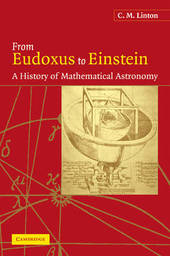
|
From Eudoxus to Einstein: A History of Mathematical Astronomy
Paperback / softback
Main Details
| Title |
From Eudoxus to Einstein: A History of Mathematical Astronomy
|
| Authors and Contributors |
By (author) C. M. Linton
|
| Physical Properties |
| Format:Paperback / softback | | Pages:532 | | Dimensions(mm): Height 226,Width 153 |
|
| Category/Genre | History of science |
|---|
| ISBN/Barcode |
9780521045711
|
| Classifications | Dewey:520.151 |
|---|
| Audience | | Professional & Vocational | |
|---|
| Illustrations |
15 Tables, unspecified; 5 Halftones, unspecified; 87 Line drawings, unspecified
|
|
Publishing Details |
| Publisher |
Cambridge University Press
|
| Imprint |
Cambridge University Press
|
| Publication Date |
20 December 2007 |
| Publication Country |
United Kingdom
|
Description
Since man first looked towards the heavens, a great deal of effort has been put into trying to predict and explain the motions of the sun, moon and planets. Developments in man's understanding have been closely linked to progress in the mathematical sciences. Whole new areas of mathematics, such as trigonometry, were developed to aid astronomical calculations, and on numerous occasions throughout history, breakthroughs in astronomy have only been possible because of progress in mathematics. This book describes the theories of planetary motion that have been developed through the ages, beginning with the homocentric spheres of Eudoxus and ending with Einstein's general theory of relativity. It emphasizes the interaction between progress in astronomy and in mathematics, showing how the two have been inextricably linked since Babylonian times. This valuable text is accessible to a wide audience, from amateur astronomers to professional historians of astronomy.
Author Biography
Christopher Linton is Head of the Mathematical Sciences Department at Loughborough University.
Reviews'Linton presents the 4000 year history of astronomy from a refreshingly different viewpoint ... His treatment is thorough and clear, but not daunting.' New Scientist 'The homework requisite for the task Linton has undertaken is demanding, both in extent and depth. He has done it thoroughly and well.' Journal for the History of Astronomy
|